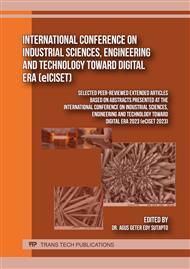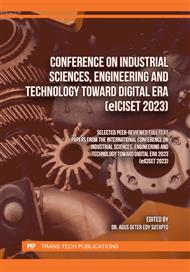[1]
A. Budiwibowo, B. Trigunarsyah, I. S. Abidin, and H. G. Soeparto, "Competitiveness of the Indonesian Construction Industry," Journal of Construction in Developing Countries, vol. 14, no. 1, p.51–68, 2009.
Google Scholar
[2]
M. K. Buniya, I. Othman, R. Y. Sunindijo, and A. F. Kineber, "Barriers to Safety Program Implementation in the Construction Industry," Ain Shams Engineering Journal, vol. 12, p.65–72, 2021.
DOI: 10.1016/j.asej.2020.08.002
Google Scholar
[3]
A. M. Dale, R. Colvin, M. Barrera, J. R. Strickland, and B. A. Evanoff, "The Association between Subcontractor Safety Management Programs and Worker Perceived Safety Climate in Commercial Construction Projects," Journal of Safety Research, vol. 74, p.279–288, 2020.
DOI: 10.1016/j.jsr.2020.06.010
Google Scholar
[4]
P. Hughes and E. Ferret, "Construction Site Issues - Hazards and Control," in Introduction to Health and Safety in Construction (Third Edition), Routledge, 2015, p.173–184.
DOI: 10.1016/b978-1-85617-521-0.50017-1
Google Scholar
[5]
Y. Lee, M. Shariatfar, A. Rashidi, and H. W. Lee, "Evidence-driven Sound Detection for Prenotification and Identification of Construction Safety Hazards and Accidents," Automation in Construction, vol. 113, p.103127, 2020.
DOI: 10.1016/j.autcon.2020.103127
Google Scholar
[6]
International Labour Organization, "World Statistic: The Enormous Burden of Poor Working Conditions," 2011. https://www.ilo.org/moscow/areas-of-work/occupational-safety-and-health/WCMS_249278/lang--en/index.htm#:~:text=The%20ILO%20estimates%20that%20some,of%20work%2Drelated%20illnesses%20annually. (accessed Jul. 28, 2023).
Google Scholar
[7]
National Safety Council, "Industry Incidence and Rates," NSC Injury Facts, 2021. https:// injuryfacts.nsc.org/work/industry-incidence-rates/industry-profiles/(accessed Jul. 28, 2023).
Google Scholar
[8]
S. Samanta and J. Gochhayat, "Critique on occupational safety and health in construction sector: An Indian perspective," Materials Today: Proceedings, vol. 80, no. 3, p.3016–3021, 2021.
DOI: 10.1016/j.matpr.2021.05.707
Google Scholar
[9]
E. Abukhashabah, A. Summan, and M. Balkhyour, "Occupational accidents and injuries in construction industry in Jeddah city," Saudi Journal of Biological Sciences, vol. 27, p.1993–1998, 2020.
DOI: 10.1016/j.sjbs.2020.06.033
Google Scholar
[10]
P. Kesai, R. Soegiarso, S. Hardjomuljadi, M. I. Setiawan, D. Abdullah, and D. Napitupulu, "Indonesia Position in the Globalization of Construction Industry," Journal of Physics: Conference Series, vol. 1114, p.012133, 2018.
DOI: 10.1088/1742-6596/1114/1/012133
Google Scholar
[11]
Y. Petriella, "Kontribusi Pengembang Kurangi Angka Kecelakaan Kerja Konstruksi," Bisnis Indonesia, 2022. https://bisnisindonesia.id/article/kontribusi-pengembang-kurangi-angka-kecelakaan-kerja-konstruksi (accessed Jul. 31, 2023).
DOI: 10.32672/jse.v8i3.6419
Google Scholar
[12]
H. B. Alexander, "Kecelakaan Konstruksi Tinggi, K3 Harus Digencarkan di Proyek Rumah Tapak," Kompas.com, 2022. https://www.kompas.com/properti/read/2022/11/29/190000821/kecelakaan-konstruksi-tinggi-k3-harus-digencarkan-di-proyek-rumah-tapak (accessed Jul. 31, 2023).
DOI: 10.26623/teknika.v17i2.4867
Google Scholar
[13]
T. Ghuzdewan and P. Damanik, "Analysis of Accident in Indonesian Construction Projects," MATEC Web of Conferences, vol. 258, p.02021, 2019.
DOI: 10.1051/matecconf/201925802021
Google Scholar
[14]
A. Albert, B. Pandit, and Y. Patil, "Focus on the Fatal-Four: Implications for Construction Hazard Recognition," Safety Science, vol. 128, no. 104774, 2020.
DOI: 10.1016/j.ssci.2020.104774
Google Scholar
[15]
P. F. Tunji-Olayeni, A. O. Afolabi, and O. I. Okpalamoka, "Survey dataset on occupational hazards on construction sites," Data in Brief, vol. 18, p.1365–1371, 2018.
DOI: 10.1016/j.dib.2018.04.028
Google Scholar
[16]
B. Spurlock, Physical Hazards of the Workplace, 2nd Ed. Boca Raton, FL: CRC Press, 2018.
Google Scholar
[17]
A. K. Mishra and P. S. Aithal, "Job Safety Analysis during Tunnel Construction," International Journal of Applied Engineering and Management Letters, vol. 5, no. 1, p.80–96, 2021.
DOI: 10.47992/ijaeml.2581.7000.0094
Google Scholar
[18]
S. M. Salim, F. I. Romli, J. Besar, and N. O. Aminian, "A Study on Potential Physical Hazards at Construction Sites," Journal of Mechanical Engineering, vol. 4, no. 1, p.207–222, 2017.
Google Scholar
[19]
N. Adepu, S. Kermanshachi, and A. Pamidimukkala, "Analysis of Impact of COVID-19 and Other Occupational Infectious Diseases on Construction of Transportation Projects," in International Conference on Transportation and Development 2022, Seattle, Washington: ASCE, 2022.
DOI: 10.1061/9780784484364.015
Google Scholar
[20]
M. N. Abdol Rahman and N. L. Hanum Samin, "Risk Assessment of Occupational Safety & Health (OSH) Hazards at Small and Medium Enterprise (SME)," Research Progress in Mechanical and Manufacturing Engineering, vol. 2, no. 2, p.343–353, 2021.
Google Scholar
[21]
Government Institutes, Construction Industry Digest and All About OSHA. Maryland, UK: The Scarecrow Press, Inc, 2008.
Google Scholar
[22]
S. Al-Haadir and K. Panuwatwanich, "Critical Success Factors for Safety Program Implementation among Construction Companies in Saudi Arabia," Procedia Engineering, vol. 14, p.148–155, 2011.
DOI: 10.1016/j.proeng.2011.07.017
Google Scholar
[23]
S. Zhang, K. Sulankivi, M. Kiviniemi, I. Romo, C. M. Eastman, and J. Teizer, "BIM-based Fall Hazard Identification and Prevention in Construction Safety Planning," Safety Science, vol. 72, p.31–45, 2015.
DOI: 10.1016/j.ssci.2014.08.001
Google Scholar
[24]
R. Xiong, Y. Song, H. Li, and Y. Wang, "Onsite Video Mining for Construction Hazards Identification with Visual Relationships," Advanced Engineering Informatics, vol. 42, p.100966, 2019.
DOI: 10.1016/j.aei.2019.100966
Google Scholar
[25]
Y. Ouyang and X. Luo, "Differences between Inexperienced and Experienced Safety Supervisors in Identifying Construction Hazards: Seeking Insights for Training the Inexperienced," Advanced Engineering Informatics, vol. 52, p.101602, 2022.
DOI: 10.1016/j.aei.2022.101602
Google Scholar
[26]
A. Spirina, A. Mironov, R. Datkhuzheva, A. Maksimov, and N. Belova, "Analysis of Occupational Injuries in Construction and Offer of a Technical Solution Increasing Tower Crane Stability," Transportation Research Procedia, vol. 68, p.559–565, 2023.
DOI: 10.1016/j.trpro.2023.02.076
Google Scholar
[27]
Occupational Safety and Health Administration, Recommended Practices for Safety and Health Programs. 2016. [Online]. Available: osha.gov/safetymanagement
Google Scholar
[28]
The Minister of Manpower of the Republic of Indonesia, Regulation of the Minister of Manpower of the Republic of Indonesia Number 5 of 2018 concerning Occupational Safety and Health in the Work Environment. 2018.
Google Scholar
[29]
F. E. B. Setyawan, "Prevention of noise induced hearing loss in worker: A literature review," Jurnal Kedokteran dan Kesehatan Indonesia, 2021.
DOI: 10.20885/JKKI.Vol12.Iss2.art12
Google Scholar
[30]
Mariam Akinlolu and Theo C Haupt, "Prevalence of the Hand-Arm Vibration Syndrome (HAVS) Among Construction Workers in South Africa," 2023.
DOI: 10.1007/978-3-031-22434-8_49
Google Scholar
[31]
J. Foster, S. G. Hodder, A. B. Lloyd, and G. Havenith, "Individual Responses to Heat Stress: Implications for Hyperthermia and Physical Work Capacity," Sec. Environmental, Aviation and Space Physiology, vol. 11, 2020.
DOI: 10.3389/fphys.2020.541483
Google Scholar
[32]
H. A. Mohamed, "Occupational Hazards and their Relation with Health Problems among Construction Building Workers at El Sherouk City," American Journal of Nursing Research, vol. 5, no. 3, p.96–103, 2017.
Google Scholar
[33]
J. Dutkiewicz, E. Cisak, J. Sroka, A. Wójcik-Fatla, and V. Zając, "Biological agents as occupational hazards-selected issues,"Ann Agric Environ Med, vol.18, no. 2, p.286–293, 2011.
DOI: 10.5604/12321966.1185758
Google Scholar
[34]
International Labour Organization, "Biological hazards in the working environment," 2022.
Google Scholar
[35]
A. Barrow, S. P. S. Jatta, M. Nget, and R. A. Kuye, "Occupational Health and Safety Risks and Hazards among Workers in the Gambian Building Construction Sites: A Mixed-Method Study Design," Journal of Scientific Research & Reports, vol. 27, no. 9, p.19–31, 2021.
DOI: 10.9734/jsrr/2021/v27i930432
Google Scholar
[36]
S. Shrestha, "Occupational Hazards in Building Construction," SCITECH Nepal, 2021.
DOI: 10.3126/scitech.v15i1.49098
Google Scholar
[37]
T. Kowalik, Dominik Logoń, M. Maj, J. Rybak, A. Ubysz, and A. Wojtowicz, "Chemical hazards in construction industry," E3S Web of Conferences, vol. 97, 2019.
DOI: 10.1051/e3sconf/20199703032
Google Scholar
[38]
M. K. Boakye et al., "A Relative Importance Index Approach to On-Site Building Construction Workers' Perception of Occupational Hazards Assessment," Medicina del Lavoro, vol. 114, no. 3, p.1–12, 2023.
Google Scholar
[39]
M. P. Koirala, "Safety Awareness of Workers for Construction Sites in Nepal," Journal of Advanced Research in Civil and Environmental Engineering, vol. 5, no. 4, p.34–41, 2018.
DOI: 10.24321/2393.8307.201804
Google Scholar
[40]
T. Babu and A. S. Xavier, "Ergonomic Analysis of Building Construction Workers Using RII Method," International Research Journal of Engineering and Technology (IRJET), vol. 5, no. 11, p.601–605, 2018.
Google Scholar
[41]
G. A. Fordjour, A. P. C. Chan, and L. Tuffour-Kwarteng, "Exploring Construction Employees' Perspectives on the Potential Causes of Psychological Health Conditions in the Construction Industry: A Study in Ghana," International Journal of Construction Education and Research, vol. 17, no. 3, 2020.
DOI: 10.1080/15578771.2020.1804491
Google Scholar



